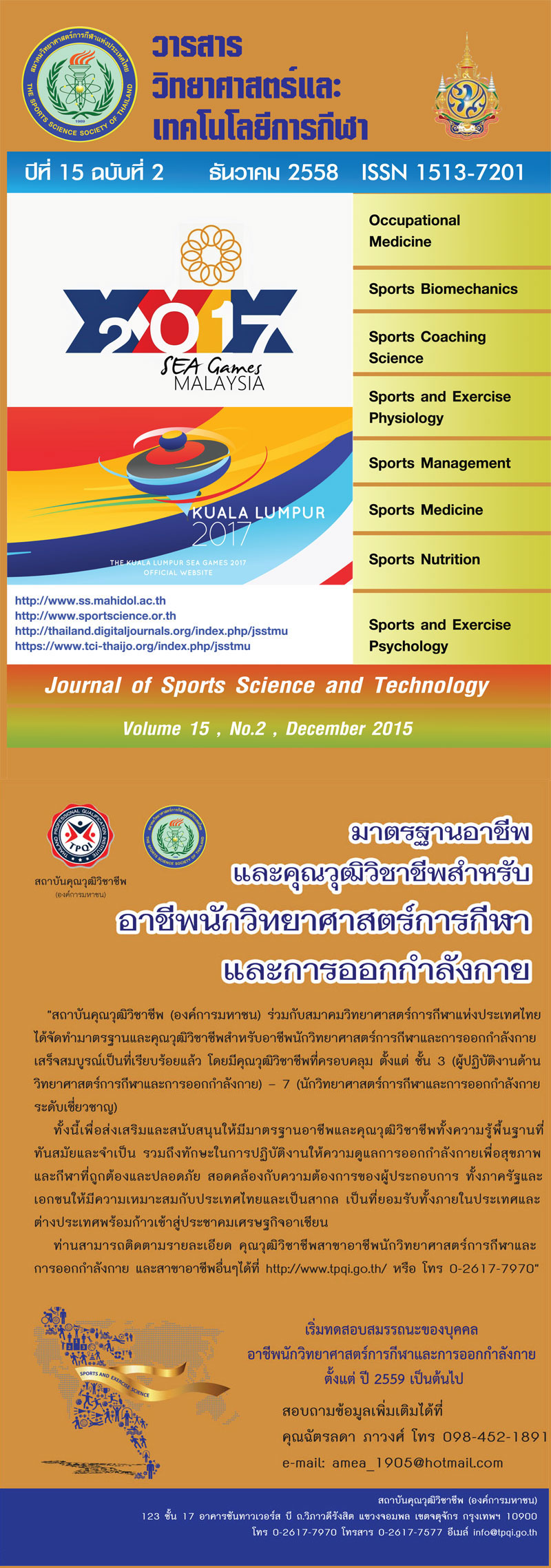THE EFFECT OF POST ACTIVATION POTENTIATION WARM UP ON SPEED AND H-REFLEX
คำสำคัญ:
Post Activation Potentiation (PAP), H-reflex, Speedบทคัดย่อ
The purposes of this research were to study and compare the effect of Post Activation Potentiation (PAP) warm-up on speed of 40 meter running and H –reflex. Subject were eleven healthy males age between 18-22 years in the faculty of Sports Science at Kasetsart University, Kampaengsaen campus. Subjects performed 3 different warm-up protocols by using the cross-over design. The warm up protocols consisted of Program 1: back squat 3 repetitions at 90% of 1 RM (BS90), Program 2 countermovement jump 3 repetitions with load 40% of 1 RM (LCMJ40), and Program 3 countermovement jump 3 repetitions with load 50% of 1 RM (LCMJ50). There were running test speed 40 meter and H-reflex before and after completed each protocol at 4 minutes and 9 minutes. The data were analyzed by using one way ANOVA with repeated measures and the multiple comparisons testing using the Tukey’s method. All testing used the 0.05 level of significance.The results of this study showed that speed of 40 meter running test was significantly different that post-test at 9 minutes (5.93 ± 0.10) better than pre-test (6.05 ± 0.11) in LCMJ40 (P<0.05). H amplitude was significantly different that post-test 4 minutes (2.95 ± 0.46) and 9 minutes (2.96 ± 0.58) decreased from pre-test (3.56 ± 0.56) in LCMJ40 (P<0.05). However, there were significantly difference of H latency that post-test better than pre-test of 3 protocols (P<0.05). There were no significant differences of speed and H-reflex among 3 different warm-up protocols (P>0.05). In conclusion, the program of LCMJ40 resulted that speed of 40 meters had better after warm up and the H latency was decreased. It meant that the nerve conduction may be fast.
(Journal of Sports Science and Technology 2015; 15(2); 123-132)
ดาวน์โหลด
เผยแพร่แล้ว
2015-12-28
รูปแบบการอ้างอิง
1.
Pongsa P, RUANGTHAI R, PHIMPHAPHORN P. THE EFFECT OF POST ACTIVATION POTENTIATION WARM UP ON SPEED AND H-REFLEX. J Sports Sci Technol [อินเทอร์เน็ต]. 28 ธันวาคม 2015 [อ้างถึง 12 ธันวาคม 2025];15(2):123-32. available at: https://he01.tci-thaijo.org/index.php/JSST/article/view/44941
ฉบับ
ประเภทบทความ
Research Article






